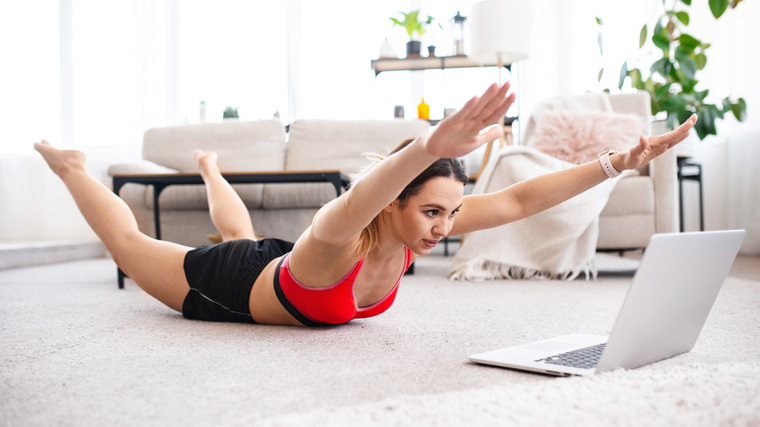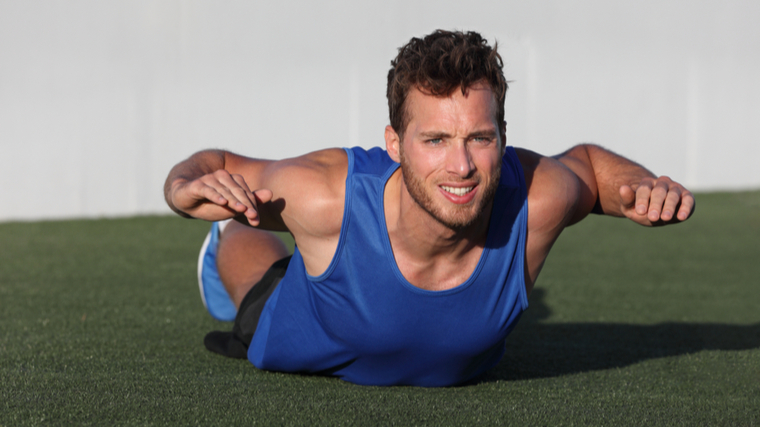Although the superman exercise will not enable you to jump over tall buildings in a single bound nor grant you the ability to soar through the air at the speed of light, it can give you the power to better strengthen your back, improve your posture, and build a better mind-muscle connection.
The superman is a simple way to train the important muscles of the lower and upper back. It strengthens them for more challenging, heavier exercises like the squat, deadlift, and bench press. It’s a great exercise to be used in warm-ups for injury prevention and muscle activation purposes.
If you’re looking for a bodyweight exercise to strengthen your posterior muscles, look no further than the superman.
Benefits of the Superman
- Reduces Low Back Pain
- Improves Posture
- Adaptable and Accessible
- Improves Spine Stability
- Guards Against Injury
- Boosts Athletic Performance
Reduces Low Back Pain
Functionally, the superman is an isometric hold, which increases the time under tension. It’s a targeted movement focusing on the muscles in the mid and low back, as well as the glutes. Having a strong low back can help prevent back pain — in fact, studies suggest that strengthening the lumbar can significantly reduce chronic and acute back pain. (1) When performed properly, the superman is a great way to strengthen the lower back.
Improves Posture
You might spend many hours every day hunched over your computer or phone. If you aren’t mindful of your posture, we may slouch even when you’re on your feet.
Studies suggest that poor posture can result in back and neck pain, as well as decreased function in the torso. (2) The superman helps to strengthen the erector spinae muscles, which are the muscles that run along your spine. Strong spinal erectors play an important role in maintaining good posture and keeping a neutral spine during heavy loaded movements.
Adaptable and Accessible
Beginner lifters may have less body awareness, which is important to possess in order to maintain proper form. The superman movement is a great exercise to teach beginning lifters what extension of the back and glutes feels like. Developing the extension movements of hips, hamstrings, and lower back are vital for strong big three lifts and supermans can be done safely off the floor to help hone in on muscle awareness.
Improves Spine Stability
The superman strengthens the erector muscles that run along the spine. They play an important role in spinal stability and preventing unwanted movement in the lower back. This is handy when your spine is under heavy loads while squatting and deadlifting. The superman also recruits the abdominals, which are important for spine stability.

Studies suggest that the abdominal muscles contribute to spine stability, and strengthening them can help increase it. (3) A stable spine is important not only in helping reduce the risk of injury, but it also helps in everyday flexibility and mobility.
Guards Against Injury
The superman happens to be useful for strength, power, and fitness athletes for injury prevention purposes. It recruits stabilizer muscles like the muscles in the abdominal and mid to lower back, which are important contributions to safer, more efficient lifts.
A stronger core and back can help weightlifters, powerlifters, and the average gym-goer prevent injury when lifting heavy loads. Research suggests that core stabilization exercises can help reduce the risk of overall injuries. (4)
Boosts Athletic Performance
One of the larger muscles the superman targets are the glutes. They are responsible for hip stability and helping you walk, run, and stay upright. Studies suggest that glute activation is high in exercises such as the step-up, squat, deadlift, and lunge. These exercises can be important for CrossFitters, weightlifters, and powerlifters who tend to see at least a few of these exercises often. Strong glutes can improve jumping and running performance. (5)
How to Do the Superman
The superman seems like a pretty simple movement, but it can be fairly easy to do improperly. Straying from correct form on this move can quickly diminish the benefits it provides. The margin between beneficial movement and just flopping around on the ground is slim, so here’s how to do it right.
- Lie face down comfortably on the mat, forehead flat on the ground, and keep your arms and legs outstretched.
- Squeeze your glutes, low back, and core to raise your arms and feet approximately four to five inches off the floor — or however high you can fly — while keeping your core on the ground.
- Hold this raised position for three seconds and then lower your hands and feet slowly back to the floor.
Superman Variations
Although the range of motion is low and the movement itself is pretty tame once you’ve learned to do it correctly, that doesn’t mean there aren’t ways to spice it up. Below are some of the more valuable variations you can try out once you’re feeling up to it.
Reverse Hollow Hold
For the reverse hollow hold, you maintain a contracted superman position and then rock forward and backward. This is reminiscent of a hollow rock, except in prone rather than supine. The rocking can help improve your body control, core strength, and it can be rather fun.
Isometric Hold and Roll
The isometric hold and roll is actually a combination between a superman and a hollow hold. It trains the anterior core along with the posterior core and is a great segue to more advanced movements found in bodyweight training and gymnastics. The movement starts in a superman and flips into a hollow hold.
Bird Dog
This variation is beneficial for improving coordination, balance, and could be a good option for pregnant or postpartum women approved by their doctor. The bird dog requires stability of the body and can help with posture and strengthen the erector spinae just like the superman. Since you’re on all fours and not lying down, it can help reduce stress in the low back.
Alternating Superman
All the cues are the same for the alternating superman, except you’re only moving one leg and arm at a time. This is a good variation for anyone who feels strain during the standard superman or don’t have the coordination or balance yet. Alternating arms and legs makes this a beneficial progression to the superman.
Swimmer
The swimmer is a more challenging variation of the superman since once your feet and hands leave the ground, they don’t touch back down again. The isometric position alone requires more strength and stability, and adding the quick movement of the opposing limbs challenges your coordination.
When to Do the Superman
One of the biggest tertiary benefits of an exercise like the superman is its versatility. Since you don’t need a barbell to get value from the exercise, you can plug the superman into nearly any point in your workout routine.

[Read More: The Best Bodyweight Exercises, + Workouts and Tips From a CPT]
If you’re performing it for postural benefits or preventative care, the superman may have a place in your morning routine, or when you’re not at the gym to train. However, if you’re using it to develop some isometric strength and bodily control, add a couple of sets into your general warm-up to help augment your subsequent exercises.
Let’s Fly
The superman exercise is one of those exercises that’s often neglected because it seems too simple to work and lifters bypass it for more complex exercises. However, the superman and its variations can strengthen your posterior muscles without the need for elaborate equipment.
Calisthenic exercises like the superman can be just as important as barbell and dumbbell exercises because they can help hit those stabilizer muscles that the weighted exercises may not get at. Total-body stability and control is the secret ingredient to help you soar through a safer, more efficient workout.
References
- Dreisinger, Thomas E. Exercise in the Management of Chronic Back Pain. The Ochsner Journal. 2014. 14(1).
- Cramer, Holger, Mehling, Wolf E., & Saha, Felix J. Postural awareness and its relation to pain: validation of an innovative instrument measuring awareness of body posture in patients with chronic pain. BMC Musculoskeletal Disorders. 2018; 19. doi: 10.1186/s12891-018-2031-9
- Stokes, Ian AF, Gardner-Morse, Mack G., Henry, Sharon M. Abdominal Muscle Activation Increases Lumbar Spinal Stability: Analysis of Contributions of Different Muscle Groups. Clin Biomed. 2011; 26(8). doi: 10.1016/j.clinbiomech.2011.04.006
- Huxel Bliven, Kellie C., Anderson, Barton E. Core Stability Training for Injury Prevention. Sports Health. 2013; 5(6) doi: 10.1177/1941738113481200
- Gallego-Izquierdo, Tomas, Vidal-Aragon, Gerardo, & Calderon-Corrales, Pedro. Effects of a Gluteal Muscles Specific Exercise Program on the Vertical Jump. International Journal of Environmental Research and Public Health. 2020; 17(15). doi: 10.3390/ijerph17155383
Featured Image: Admiral / Shutterstock